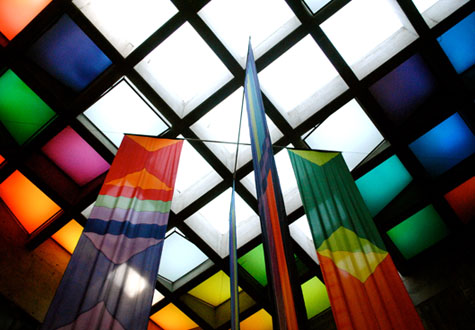Surrounded by the hustle and bustle of everyday life, very seldom do we come across a space, which transcends the shackles of our hectic, technologically modern lifestyles. To a large number of us University of Western Ontario students, we have become exceedingly removed from experiencing not only the beauty–or lack thereof–within our public environments, but we have dismissed how these spaces determine our behaviour and our functions.
Despite existing in our own backyard, a space that has gone without much notice is Brescia University College’s Rose parlour and dining room (figure 1). Ursuline Hall, atop the picturesque grassy hill of Brescia’s campus, is host to this unique interior environment. Already, the physical pedestal of its location and the single laneway leading to high-arched solid wood doors of the gothic style building make access seem special and exclusive. Ursuline Hall itself is a visual and ambient delight. Adorned with high ceilings, marble-clad walls, winding stairways, religious sculpture, and beautifully tiled floors, the open foyer leading to the Rose Room sets the stage for the decadent eclectic revival of the space. The adjacent chapel also complements and foretells the sacred-like character of the parlour and dining area.
The Rose Room itself holds a sort of exclusivity as it is used only for special occasions and can be occupied only upon appointment. The doors to the room are glass paneled but are covered by sheers, preventing those passing by from peering in. This barrier, by design, seems to echo the room’s exclusivity. It is usually locked due its special purpose and perhaps also because of the value of its artifacts. The parlour and dining room were originally used for special occasions such as welcoming new students and faculty to Brescia or as a venue for final addresses to graduates. Today, this has since changed as the room is reserved for small celebratory events as well as special meetings.
Upon entry to the room, guests can expect an immediate feeling of comfort, luxury and formality (figure 2). From a quick scan, one notices long, full, and heavy velvet curtains accompanied with billowing lace sheers, a patterned rug, ornate dark wood furniture, generously upholstered seating, elaborate chandeliers, and a vast array of religious ornamentation, all set amongst a warm and rich colour palette. These elements, in part, reflect the eclecticism of a Victorian aesthetic. There are also some assets, which recall the feeling of medieval elegance. These features make reference to the Gothic era, paying homage to A.W.N. Pugin’s revival of a ‘high moral standard’. This aesthetic involves the presence of devotional artifacts in order to convey religious values. The various religious knickknacks, figures, paintings, photographs and prints suggest an affinity with this look. As well, the use of deep jewel tones, the heavy wooden table and strong dining light fixtures relate to the Gothic revival style.
Since the Rose Room lacks high medieval-style ceilings, it succeeds at offering a sense of intimacy with its guests (figure 3). The warm colour palette also fosters this relationship. The arrangement of furniture, and its concentration around the perimeters of the room, allows for an open, communal space, however, the wooden partition allows the option of division. The golden walls and hardwood floors also compliment the open plan of the room, allowing both the natural light from the large windows and the artificial light from the fixtures to reflect off the amber hues, similar to an Art Nouveau aesthetic shown here. These properties are significant as they form a dichotomy between the exclusive access to the room and the communal feeling once inside the environment.
The Rose Room also poses as a historical repository of Brescia-specific artifacts. Decorative accessories, embellished furnishings, and artwork are among the noted pieces. The most distinguished and oldest piece in the room is the Spanish Varguena–a writing desk–believed to have been made during the Spanish Renaissance. Purchased in Palm Beach Florida by Colonel Maclean of the MacLean Publishing Company, it was presented to Mother Clare. Interestingly, MacLean thought this piece would be best appreciated at Brescia. A complete list of the origins, significance, and alterations of the artifacts found in the Rose Room can be found here (please refer to “Rose Parlour and Dining Room” subheading of the webpage).
Although the eclectic array of time-specific artifacts seem to harmoniously correspond to form a coherent aesthetic, there exist some notable disruptions in the stylistic unity of the space (figure 4). A rotating fan, a call display office phone, and mismatched, poppy-red candlesticks discredit the space with hints of modernity. The most distracting and unfortunate display of inconsistency is the poster board atop the 16th century Varguena. The historically and aesthetically significant artifact is hindered by the colourful campus promotion (figure 5). In addition to these objects, the cyclical whirring of outdoor ventilation, and disenchanted view of bricked shoebox type buildings through the windows also seem to interrupt the room’s ability to transcend modern time. Fortunately, the view is stifled by thick lace sheers and the industrial humming loses its voice among the lively conversation of the room’s guests.
Overall, despite the mildly distracting modern aesthetic elements, it is the consistency amongst the amalgamation of time-specific artifacts, furnishings, and décor that lend credence to the authenticity, intrigue, and formality of the Rose Room. Subjects can allow themselves to transcend present time. The fact that it feels wrong to check a Blackberry for incoming messages within the space speaks volumes. Guests are enabled to foster sacred communion of sorts within the space, and within its history.
|













